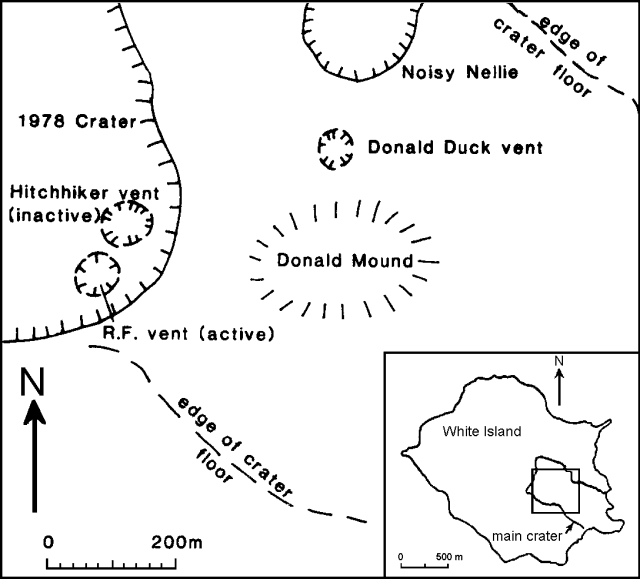Report on Whakaari/White Island (New Zealand) — March 1989
Scientific Event Alert Network Bulletin, vol. 14, no. 3 (March 1989)
Managing Editor: Lindsay McClelland.
Whakaari/White Island (New Zealand) Explosions continue from two new vents
Please cite this report as:
Global Volcanism Program, 1989. Report on Whakaari/White Island (New Zealand) (McClelland, L., ed.). Scientific Event Alert Network Bulletin, 14:3. Smithsonian Institution. https://doi.org/10.5479/si.GVP.SEAN198903-241040
Whakaari/White Island
New Zealand
37.52°S, 177.18°E; summit elev. 294 m
All times are local (unless otherwise noted)
Activity from R.F. Crater declined to intermittent ash emission in February and March. When helicopter pilot Robert Fleming visited White Island on 14 February, R.F. Crater was emitting ash. Additional tephra was found in the Blue Duck-Donald Mound area (figure 11) about 200 m to the E. On 19 February, R.F. Crater was quiet. Fleming's subsequent visits on 25 and 27 February and 5 March revealed that the new Donald Duck vent, about 40 m N of Donald Mound and first seen 29 January, had grown and ejected tephra. R.F. Crater was no longer emitting much ash during those visits.
 |
Figure 11. Sketch map, showing recently active features on White Island, early 1989. The area shown is indicated by the box on the index map. Courtesy NZGS. |
Vigorous explosions occurred 26 February and 14 March, producing tephra columns visible from the mainland (>50 km away). Both were accompanied by E-type earthquakes. The 14 March explosion, the largest magmatic event since early April 1988 (SEAN 13:04), scattered scoria bombs over the S margin of the main crater floor.
During geological fieldwork two days later, R.F. Crater emitted a light-pink steam plume. The Donald Duck vent was surrounded by new lithic blocks and had enlarged to 20 m in diameter and 10 m in depth. Vents on its floor emitted brown gas and intermittent ash.
Donald Duck vent erupted between 16 and 20 March, probably during a 25-minute E-type earthquake sequence that started at 1624 on 16 March. The blast was directed SSE, depositing gray-white coarse gravel near the vent and blocks up to 300 m away. No fresh scoria was found. The eruption enlarged the vent to 15 m deep and 30 m in diameter. Between 9 February and 20 March, >10 cm of new ash and lapilli had accumulated at the 1978 Crater rim. Red glow, probably caused by incandescent gas emission, was seen during the night of 21 March from Whakatane (50 km SSW ). No unusual seismic activity was recorded.
Fumarole temperatures declined after 9 February, probably due to heavy rainfall. Magnetic and crater floor deformation surveys suggested no significant rise of magma. Two months of inflation in the vicinity of the Donald Duck vent had ended, with deflation occurring between surveys on 9 February and 16 and 20 March.
Seismicity 9 February-16 March consisted of medium-to-strong high-frequency microearthquakes and persistent small A- and B-type events. Harmonic tremor and rare E-types were also recorded. After 22 February, B-type events averaged ~9/day. Low-amplitude, 1.5- to 2-Hz tremor was recorded 19 and 20 February. E-type shocks were recorded 22, 24, and 26 February, and 14 and 16 March.
Geological Summary. The uninhabited Whakaari/White Island is the 2 x 2.4 km emergent summit of a 16 x 18 km submarine volcano in the Bay of Plenty about 50 km offshore of North Island. The island consists of two overlapping andesitic-to-dacitic stratovolcanoes. The SE side of the crater is open at sea level, with the recent activity centered about 1 km from the shore close to the rear crater wall. Volckner Rocks, sea stacks that are remnants of a lava dome, lie 5 km NW. Descriptions of volcanism since 1826 have included intermittent moderate phreatic, phreatomagmatic, and Strombolian eruptions; activity there also forms a prominent part of Maori legends. The formation of many new vents during the 19th and 20th centuries caused rapid changes in crater floor topography. Collapse of the crater wall in 1914 produced a debris avalanche that buried buildings and workers at a sulfur-mining project. Explosive activity in December 2019 took place while tourists were present, resulting in many fatalities. The official government name Whakaari/White Island is a combination of the full Maori name of Te Puia o Whakaari ("The Dramatic Volcano") and White Island (referencing the constant steam plume) given by Captain James Cook in 1769.
Information Contacts: I. Nairn, NZGS Rotorua.

